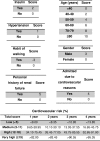A four-year cardiovascular risk score for type 2 diabetic inpatients
- PMID: 26056618
- PMCID: PMC4458124
- DOI: 10.7717/peerj.984
A four-year cardiovascular risk score for type 2 diabetic inpatients
Abstract
As cardiovascular risk tables currently in use were constructed using data from the general population, the cardiovascular risk of patients admitted via the hospital emergency department may be underestimated. Accordingly, we constructed a predictive model for the appearance of cardiovascular diseases in patients with type 2 diabetes admitted via the emergency department. We undertook a four-year follow-up of a cohort of 112 adult patients with type 2 diabetes admitted via the emergency department for any cause except patients admitted with acute myocardial infarction, stroke, cancer, or a palliative status. The sample was selected randomly between 2010 and 2012. The primary outcome was time to cardiovascular disease. Other variables (at baseline) were gender, age, heart failure, renal failure, depression, asthma/chronic obstructive pulmonary disease, hypertension, dyslipidaemia, insulin, smoking, admission for cardiovascular causes, pills per day, walking habit, fasting blood glucose and creatinine. A cardiovascular risk table was constructed based on the score to estimate the likelihood of cardiovascular disease. Risk groups were established and the c-statistic was calculated. Over a mean follow-up of 2.31 years, 39 patients had cardiovascular disease (34.8%, 95% CI [26.0-43.6%]). Predictive factors were gender, age, hypertension, renal failure, insulin, admission due to cardiovascular reasons and walking habit. The c-statistic was 0.734 (standard error: 0.049). After validation, this study will provide a tool for the primary health care services to enable the short-term prediction of cardiovascular disease after hospital discharge in patients with type 2 diabetes admitted via the emergency department.
Keywords: Cardiovascular diseases; Diabetes mellitus; Emergencies; Predictive models; Primary Health Care.
Conflict of interest statement
The authors declare there are no competing interests.
Figures
Similar articles
-
Predictive models for all-cause and cardiovascular mortality in type 2 diabetic inpatients. A cohort study.Int J Clin Pract. 2015 Apr;69(4):474-84. doi: 10.1111/ijcp.12563. Epub 2014 Sep 19. Int J Clin Pract. 2015. PMID: 25234387
-
Predicting the impact of population level risk reduction in cardio-vascular disease and stroke on acute hospital admission rates over a 5 year period--a pilot study.Public Health. 2006 Dec;120(12):1140-8. doi: 10.1016/j.puhe.2006.10.012. Epub 2006 Nov 3. Public Health. 2006. PMID: 17084425
-
Effects of acarbose on cardiovascular and diabetes outcomes in patients with coronary heart disease and impaired glucose tolerance (ACE): a randomised, double-blind, placebo-controlled trial.Lancet Diabetes Endocrinol. 2017 Nov;5(11):877-886. doi: 10.1016/S2213-8587(17)30309-1. Epub 2017 Sep 13. Lancet Diabetes Endocrinol. 2017. PMID: 28917545 Clinical Trial.
-
Rationale and design of the LURIC study--a resource for functional genomics, pharmacogenomics and long-term prognosis of cardiovascular disease.Pharmacogenomics. 2001 Feb;2(1 Suppl 1):S1-73. doi: 10.1517/14622416.2.1.S1. Pharmacogenomics. 2001. PMID: 11258203 Review.
-
Contact with primary health care physicians before an acute hospitalisation.Scand J Prim Health Care. 2019 Sep;37(3):283-293. doi: 10.1080/02813432.2019.1639900. Epub 2019 Jul 9. Scand J Prim Health Care. 2019. PMID: 31286825 Free PMC article.
Cited by
-
A Prognostic Model for the Outcome of Nobel Biocare Dental Implants with Peri-Implant Disease after One Year.J Clin Med. 2019 Sep 1;8(9):1352. doi: 10.3390/jcm8091352. J Clin Med. 2019. PMID: 31480537 Free PMC article.
-
Difference between elderly and non-elderly patients in using serum lactate level to predict mortality caused by sepsis in the emergency department.Medicine (Baltimore). 2018 Mar;97(13):e0209. doi: 10.1097/MD.0000000000010209. Medicine (Baltimore). 2018. PMID: 29595662 Free PMC article.
-
Precision prognostics for cardiovascular disease in Type 2 diabetes: a systematic review and meta-analysis.Commun Med (Lond). 2024 Jan 22;4(1):11. doi: 10.1038/s43856-023-00429-z. Commun Med (Lond). 2024. PMID: 38253823 Free PMC article.
-
Construction, internal validation and implementation in a mobile application of a scoring system to predict nonadherence to proton pump inhibitors.PeerJ. 2017 Jun 30;5:e3455. doi: 10.7717/peerj.3455. eCollection 2017. PeerJ. 2017. PMID: 28674646 Free PMC article.
References
-
- Carbonell Torregrosa MA, Urtubia Palacios A, Palazón Bru A, Carrasco Tortosa V, Gil Guillén V. Impacto de la implantación del programa ASIGNA en un servicio de urgencias hospitalario. Emergencias. 2014;26:188–194.
-
- Cinza Sanjurjo S, Cabarcos Ortiz de Barrón A, Nieto Pol E, Torre Carballada JA. Prevalencia de hipertensión arterial en población mayor de 65 años ingresada en un Servicio de Medicina Interna. Anales de Medicina Interna. 2006;23:577–581. - PubMed
LinkOut - more resources
Full Text Sources
Other Literature Sources
Research Materials



